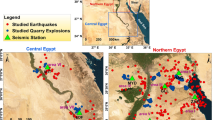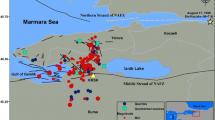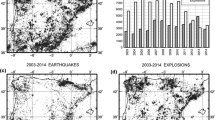Abstract
Seismic events and blasts generate seismic waveforms that have different characteristics. The challenge to confidently differentiate these two signatures is complex and requires the integration of physical and statistical techniques. In this paper, the different characteristics of blasts and seismic events were investigated by comparing probability density distributions of different parameters. Five typical parameters of blasts and events and the probability density functions of blast time, as well as probability density functions of origin time difference for neighbouring blasts were extracted as discriminant indicators. The Fisher classifier, naive Bayesian classifier and logistic regression were used to establish discriminators. Databases from three Australian and Canadian mines were established for training, calibrating and testing the discriminant models. The classification performances and discriminant precision of the three statistical techniques were discussed and compared. The proposed discriminators have explicit and simple functions which can be easily used by workers in mines or researchers. Back-test, applied results, cross-validated results and analysis of receiver operating characteristic curves in different mines have shown that the discriminator for one of the mines has a reasonably good discriminating performance.


























Similar content being viewed by others
Abbreviations
- ρ :
-
Rock density (kg/m3)
- c :
-
Velocity of the wave in rock (m/s)
- R :
-
The distance from the seismic source (m)
- J c :
-
The integral of the square of the ground velocity
- F c :
-
An empirical radiation pattern coefficient
- Ω 0 :
-
The low-frequency plateau of the frequency spectrum of a seismic waveform
- K c :
-
The Madariaga source model constant (S-wave)
- α :
-
P-wave velocity
- β :
-
S-wave velocity
- u Mag :
-
Uniaxial magnitude
- t Mag :
-
Triaxial magnitude
- M 0 :
-
Seismic moment, \(M_{0} { = }{{ 4\pi \rho c^{3} R\varOmega_{0} } \mathord{\left/ {\vphantom {{ 4\pi \rho c^{3} R\varOmega_{0} } {F_{c} }}} \right. \kern-0pt} {F_{c} }}\)
- M m :
-
Moment magnitude, \(M_{\text{m}} { = }\log \left( {M_{0} } \right){2 \mathord{\left/ {\vphantom {2 3}} \right. \kern-0pt} 3} - 6.0\)
- f c :
-
Corner frequency, \(f_{\text{c}} { = }{{\sqrt {{{S_{\text{v2}} } \mathord{\left/ {\vphantom {{S_{\text{v2}} } {S_{\text{D2}} }}} \right. \kern-0pt} {S_{\text{D2}} }}} } \mathord{\left/ {\vphantom {{\sqrt {{{S_{\text{v2}} } \mathord{\left/ {\vphantom {{S_{\text{v2}} } {S_{\text{D2}} }}} \right. \kern-0pt} {S_{\text{D2}} }}} } {2\pi }}} \right. \kern-0pt} {2\pi }}\), S v2 and S D2 are integrals of the squared spectral displacement and velocity determined over P-wave and S-wave windows
- E :
-
Total radiated energy, \(E = 4\pi \rho cR^{2} {{J_{\text{c}} } \mathord{\left/ {\vphantom {{J_{\text{c}} } {F_{\text{c}} }}} \right. \kern-0pt} {F_{\text{c}} }}\)
- E s :
-
S-wave radiated energy
- E P :
-
P-wave radiated energy
- r 0 :
-
Source radius \(r_{ 0} { = }{{K_{\text{c}} \beta } \mathord{\left/ {\vphantom {{K_{\text{c}} \beta } {\left( { 2\pi f_{ 0} } \right)}}} \right. \kern-0pt} {\left( { 2\pi f_{ 0} } \right)}}\)
- AR:
-
Asperity radius, \({\text{AR}} = 1.32\beta {{v_{\hbox{max} } } \mathord{\left/ {\vphantom {{v_{\hbox{max} } } {a_{\hbox{max} } }}} \right. \kern-0pt} {a_{\hbox{max} } }}\)
- v max :
-
Maximum velocity record(m/s) from the root-mean-square trace
- α max :
-
Maximum acceleration record (m/s2) from the root-mean-square trace
- MD:
-
The maximum displacement, \({\text{MD}} = {{8.1Rv_{ \hbox{max} } } \mathord{\left/ {\vphantom {{8.1Rv_{ \hbox{max} } } \beta }} \right. \kern-0pt} \beta }\)
- σ α :
-
Apparent stress (Pa), \(\sigma_{a} = {{\mu E} \mathord{\left/ {\vphantom {{\mu E} {M_{0} }}} \right. \kern-0pt} {M_{0} }}\)
- μ :
-
Shear modulus of rigidity of the source material (N/m2)
- SSD:
-
Static stress drop, \({\text{SSD}} = {{7M_{0} } \mathord{\left/ {\vphantom {{7M_{0} } {16r_{0}^{3} }}} \right. \kern-0pt} {16r_{0}^{3} }}\)
- Δσ d :
-
DSD, dynamic stress drop, \(\Delta \sigma_{\text{d}} = 12.61\rho R\alpha\)
- PV:
-
Peak velocity parameter, \({\text{PV}} = rv_{ \hbox{max} }\)
- PA:
-
Peak acceleration parameter, \({\text{PA}} = \rho Ra_{ \hbox{max} }\)
- Error:
-
Location error
- N s :
-
Number of sensor used
- N u :
-
Number of uniaxial sensor used
- N t :
-
Number of triaxial sensor used
- AS:
-
Apparent stress
References
Arrowsmith SJ, Arrowsmith MD, Hedlin MA, Stump B (2006) Discrimination of delay-fired mine blasts in Wyoming using an automatic time-frequency discriminant. Bull Seismol Soc Am 96(6):2368–2382
Berchialla P, Foltran F, Gregori D (2013) Naïve Bayes classifiers with feature selection to predict hospitalization and complications due to objects swallowing and ingestion among European children. Safety Sci 51(1):1–5
Blair DP (2007) A comparison of Heelan and exact solutions for seismic radiation from a short cylindrical charge. Geophysics 72(2):E33–E41
Blair DP (2010) Seismic radiation from an explosive column. Geophysics 75(1):E55–E65
Blair DP (2011) A probabilistic analysis of vibration based on measured data and charge weight scaling. In: Proceedings of the 6th EFEE world conference on explosives and blasting techniques. Lisbon, pp 319–337
Blair DP (2014) Blast vibration dependence on charge length, velocity of detonation and layered media. Int J Rock Mech Min Sci 65:29–39
Booker A, Mitronovas W (1964) An application of statistical discrimination to classify seismic events. Bull Seismol Soc Am 54(3):961–971
Bradley AP (1997) The use of the area under the ROC curve in the evaluation of machine learning algorithms. Pattern Recogn 30(7):1145–1159
Del Pezzo E, Esposito A, Giudicepietro F, Marinaro M, Martini M, Scarpetta S (2003) Discrimination of earthquakes and underwater explosions using neural networks. Bull Seismol Soc Am 93(1):215–223
Derr JS (1970) Discrimination of earthquakes and explosions by the Rayleigh-wave spectral ratio. Bull Seismol Soc Am 60(5):1653–1668
Domingos P, Pazzani M (1997) On the optimality of the simple Bayesian classifier under zero-one loss. Mach learn 29(2–3):103–130
Dong L, Li X (2013a) Comprehensive models for evaluating rockmass stability based on statistical comparisons of multiple classifiers. Math Probl Eng 2013:395096
Dong L, Li X (2013b) A microseismic/acoustic emission source location method using arrival times of PS waves for unknown velocity system. Int J Distrib Sen Netw 2013:1–8
Dong LJ, Wang FY, Bai YF (2008) A fisher discriminant analysis model for prediction of seismic liquefaction of sand soil. Near-surface geophysics and human activity. In: Wang J, Xia JH, Chen C (eds) Proceedings of 3rd international conference on environment and engineering geophysics, Wuhun, PR China, 15–20 June 2008. Science Press, Beijing, pp 146–150
Dong L, Li X, Zhao G, Gong F (2009) Fisher discriminant analysis model and its application to predicting destructive effect of masonry structure under blasting vibration of open-pit mine. Chin J Rock Mech Eng 28(4):750–756
Dong L, Li X, Xie G (2014a) An analytical solution of acoustic emission source location for known P wave velocity system. Math Probl Eng 2014:290686
Dong L, Li X, Xie G (2014b) Nonlinear methodologies for identifying seismic event and nuclear explosion using random forest, support vector machine, and naive Bayes classification. Abstr Appl Anal 2014:1–8, Article ID 459317
Dong L, Li X, Zhou Z, Chen G, Ma J (2015) Three-dimensional analytical solution of acoustic emission source location for cuboid monitoring network without pre-measured wave velocity. Trans Nonferrous Met Soc China 25(1):293–302
Dowla FU, Taylor SR, Anderson RW (1990) Seismic discrimination with artificial neural networks: preliminary results with regional spectral data. Bull Seismol Soc Am 80(5):1346–1373
Ford SR, Walter WR (2010) Aftershock characteristics as a means of discriminating explosions from earthquakes. Bull Seismol Soc Am 100(1):364–376
Frantti G (1963) Energy spectra for underground explosions and earthquakes. Bull Seismol Soc Am 53(5):997–1005
Frantti G, Levereault L (1965) Auditory discrimination of seismic signals from earthquakes and explosions. Bull Seismol Soc Am 55(1):1–25
Fu Y, Dong L (2009) Bayes discriminant analysis model and its application to the prediction and classification of rockburst. J China Univ Min Technol 38(4):56–64
Gulia L (2010) Detection of quarry and mine blast contamination in European regional catalogues. Nat Hazards 53(2):229–249
Hedlin MA, Minster JB, Orcutt JA (1990) An automatic means to discriminate between earthquakes and quarry blasts. Bull Seismol Soc Am 80(6B):2143–2160
Kim W-Y, Aharonian V, Lerner-Lam A, Richards P (1997) Discrimination of earthquakes and explosions in southern Russia using regional high-frequency three-component data from the IRIS/JSP Caucasus network. Bull Seismol Soc Am 87(3):569–588
Kuyuk H, Yildirim E, Dogan E, Horasan G (2011) An unsupervised learning algorithm: application to the discrimination of seismic events and quarry blasts in the vicinity of Istanbul. Nat Hazards Earth Syst Sci 11(1):93–100
Li X, Dong L (2014) An efficient closed-form solution for acoustic emission source location in three-dimensional structures. AIP Adv 4(2):1–8, Article ID 027110
Malovichko D (2012) Discrimination of blasts in mine seismology. In: Potvin Y (ed) Deep mining 2012. Australian Centre Geomech, Perth, pp 161–171
Musil M, Plešinger A (1996) Discrimination between local microearthquakes and quarry blasts by multi-layer perceptrons and Kohonen maps. Bull Seismol Soc Am 86(4):1077–1090
Smidt RK, McDonald LL (1976) Ridge discriminant analysis. University of Wyoming department of statistics, Technical report no. 108, Laramie, Wyoming
Taylor SR (1996) Analysis of high-frequency Pg/Lg ratios from NTS explosions and western US earthquakes. Bull Seismol Soc Am 86(4):1042–1053
Tiira T (1996) Discrimination of nuclear explosions and earthquakes from teleseismic distances with a local network of short period seismic stations using artificial neural networks. Phys Earth Planet Inter 97(1):247–268
Ursino A, Langer H, Scarfì L, Di Grazia G, Gresta S (2001) Discrimination of quarry blasts from tectonic microearthquakes in the Hyblean Plateau (Southeastern Sicily). Ann Geophys 44(4):703–722
Vallejos J, McKinnon S (2013) Logistic regression and neural network classification of seismic records. Int J Rock Mech Min Sci 62:86–95
Worth AP, Cronin MT (2003) The use of discriminant analysis, logistic regression and classification tree analysis in the development of classification models for human health effects. J Mol Struct THEOCHEM 622(1):97–111
Wüster J (1993) Discrimination of chemical explosions and earthquakes in central Europe—a case study. Bull Seismol Soc Am 83(4):1184–1212
Yıldırım E, Gülbağ A, Horasan G, Doğan E (2011) Discrimination of quarry blasts and earthquakes in the vicinity of Istanbul using soft computing techniques. Comput Geosci 37(9):1209–1217
Acknowledgments
The ACG sincerely thanks the following organizations who provided funding for this research through the Mine Seismicity and Rockburst Risk Management project: Barrick Gold of Australia, BHP Billiton Nickel West, BHP Billiton Olympic Dam, Independence Gold (LighTNing Nickel), LKAB, Perilya Limited (Broken Hill Mine), Vale Inc., Agnico-Eagle Canada, Gold Fields, Hecla USA, Kirkland Lake Gold, MMG Golden Grove, Newcrest Mining, Xstrata Copper (Kidd Mine), Xstrata Nickel Rim, and The Minerals Research Institute of Western Australia. The first author thanks the partial support of projects (11447242, 41272304) of the National Natural Science Foundation of China.
Author information
Authors and Affiliations
Corresponding author
Rights and permissions
About this article
Cite this article
Dong, L., Wesseloo, J., Potvin, Y. et al. Discrimination of Mine Seismic Events and Blasts Using the Fisher Classifier, Naive Bayesian Classifier and Logistic Regression. Rock Mech Rock Eng 49, 183–211 (2016). https://doi.org/10.1007/s00603-015-0733-y
Received:
Accepted:
Published:
Issue Date:
DOI: https://doi.org/10.1007/s00603-015-0733-y




